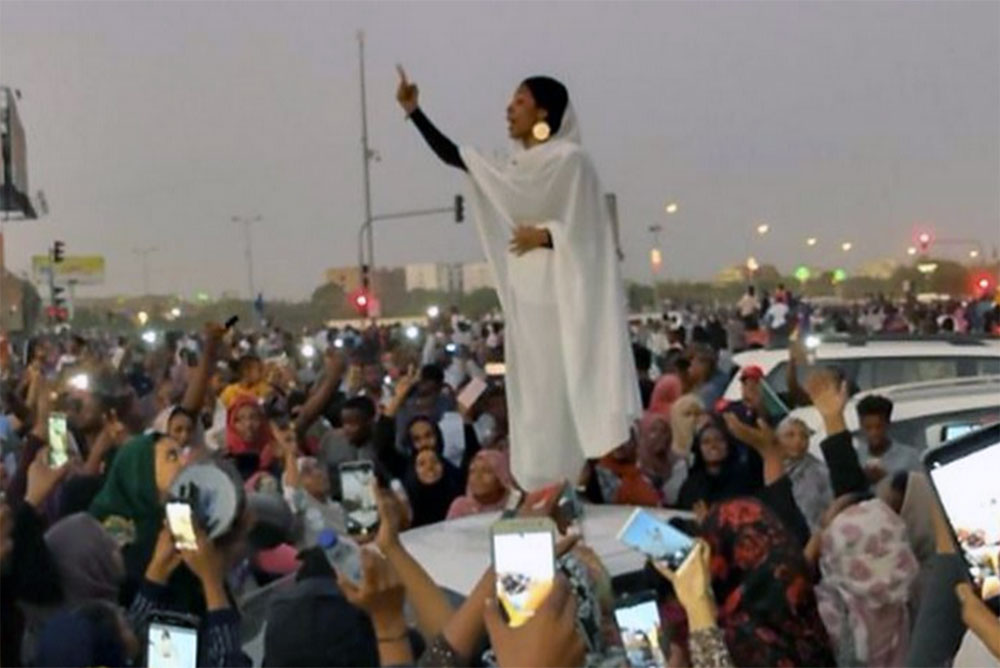
Alaa Salah, a 22-year-old Sudanese university student, led her Khartoum neighbors, men and women, in anti-regime chants. Photo via Twitter.
This article first appeared in Prime Women.
EVERYWHERE I look there are newspaper and magazine stories, indeed entire books, about modern women’s roles: how we can have it all; how we can’t, not really; which “women’s chores” successful women have ignored, downplayed, neglected, belittled, to get where they are, be it in politics, the arts, or corporate life.
Spoken or unspoken, the backdrop to these tales of triumph is the argument (discredited? reductive?) of biology as destiny, how the “natural” role of women revolves around what the Germans call “Kinder, Küche, Kirche,” although I doubt they’d mention anything about children, kitchen and church in front of German chancellor Angela Merkel, who, apropos of nothing (or maybe not), has no kids of her own. You can think of the Germans’ Three K’s as a variation on “barefoot and pregnant” or “a woman’s place is in the home.”
As the most successful women continue to struggle, it’s for more success, for equal pay for equal work, for cracks in the glass ceiling. And yet in those same newspapers and books I am bombarded with examples of women for whom biology really is destiny, and not a pretty one.
A couple of weeks ago it was the 19-year-old Bangladeshi girl who was doused with kerosene and set on fire because she wouldn’t recant allegations of inappropriate touching by her headteacher; Nusrat Jahan Rafi died 10 days later from the burns that covered 80 percent of her body. In January it was a 20-year-old Pakistani girl whose husband sliced her nose off during an argument. Closer to home, in Honduras, we New York Times readers were treated to a photo of a serene-looking 28-year-old woman in a wheelchair; in a rage, her alcoholic husband had hacked off her left foot and mutilated her right leg, the lower half of which had to be amputated. There’s so much violence against women in Honduras, the Times report said, that they’ve coined a whole new kind of murder: femicide.
Somehow, our assigned role as the “weaker sex,” seems to embolden men to act out the biology of their destiny as well, weaponizing their testosterone. Yes, of course that’s a wild exaggeration. And yet.
We may want to cross third world countries off our list of places where women can thrive. But there are enough examples, though fewer, I think, in the modern West to give us pause. The difference, it seems, is that in modern Western societies we actually try to punish the guilty.
We know that humans’ primitive lizard, or reptilian brain, regulates such basic functions as breathing and heart rate. But is there something inside the lizard brain that insists that women are prey, are weak, are natural victims? That we do in fact belong in the kitchen and not on the campaign trail or the C-suite? Or is it a social construct that has developed in the human brain, which metaphorically wraps around the lizard brain and the mammalian brain? The human brain is the one that’s supposed to be the most evolved. The jury’s still out.
I keep wondering if it’s fear that causes men to try to control women. Are we that powerful? Well, we are the ones who produce the next generation of our species. Yes, we have partners in that enterprise, but the male of the human species has been known to act like the bull elephant or, yes, the reptile, and after the “hard job” of fertilizing wander off till nature strikes again.
I have an odd habit of examining news photos of rallies and demonstrations. I’m looking for the women. In American and European protests they’re easy enough to spot (though I don’t remember seeing any women with the Unite the Right marchers in Charlottesville, Virginia, in 2017). But elsewhere in the world, chances are the only figures to be found out in public are male.
So I was heartened in early April to see, on Twitter feeds everywhere, pictures of a rally in the Sudanese capital, Khartoum. The star of the photo was a smiling woman draped in white standing atop a car leading her fellow Sudanese in anti-government chants. And in that crowd were women, lots and lots of women, who are being greatly credited with organizing the rebellion that toppled the country’s 30-year military regime. And they along with everyone else were filming the dramatic moment with their phones.
The young woman, Alaa Salah, was quickly dubbed “Sudan’s Statue of Liberty” and “Nubian Queen.” In reality, the 22-year-old is at university studying engineering and architecture. You know, doing the things modern women are supposed to do when they’re not toppling their repressive government.
Today’s it’s the government, tomorrow who knows? Maybe Alaa Salah will be kvetching about the pay disparity between her and her male engineering colleagues, maybe she’ll be angling for a post in a C-suite somewhere. And maybe she’ll also be a wife and mother, raising children to understand the power of women . . . and not to be threatened by it.
—Nancy McKeon

It’s true that I have seen no women in white nationalist activities, but, sadly, I see many at Trump rallies. I wonder what they are thinking. Anti abortion, I guess.
I think you’re probably right (about the abortion part)–and I guess I was making a possibly irrelevant distinction between rallies and protests. Good point, thanks.